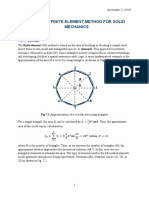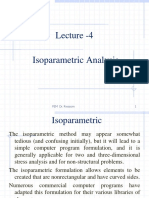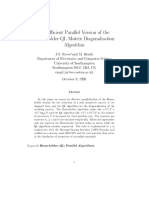CH3 Fundamentals For Finite Element Method - v2
CH3 Fundamentals For Finite Element Method - v2
Uploaded by
Eng.Hesham AL-HelaleeCopyright:
Available Formats
CH3 Fundamentals For Finite Element Method - v2
CH3 Fundamentals For Finite Element Method - v2
Uploaded by
Eng.Hesham AL-HelaleeOriginal Title
Copyright
Available Formats
Share this document
Did you find this document useful?
Is this content inappropriate?
Copyright:
Available Formats
CH3 Fundamentals For Finite Element Method - v2
CH3 Fundamentals For Finite Element Method - v2
Uploaded by
Eng.Hesham AL-HelaleeCopyright:
Available Formats
The Finite Element Structural Analysis 3.
Fundamentals for Finite Element Method
3. Fundamentals for Finite Element Method
INTRODUCTION
As mentioned before, when using the Finite Element Method (FEM) to solve mechanics problems
governed by a set of partial differential equations, the profile of the displacements is assumed for each
element in simple forms to obtain element equations.
Discretized system equations can be solved routinely for the final displacement field. The use of such a
principle guarantees the best (not exact) satisfaction of the governing system equation under certain
conditions.
FEM PROCEDURE
Domain Discretization
The solid body is divided into Ne elements. The procedure is often called meshing. Figure 3.1 shows an
example of a mesh for a two-dimensional solid. An element is formed by connecting its nodes in a pre-
defined consistent fashion to create the connectivity of the element.
Figure 3.1. Example of a mesh with elements and node properly numbered.
It is possible for the domain to consist of different types of elements with different numbers of nodes, as
long as they are compatible (no gaps and overlapping). The density of the mesh depends upon the accuracy
requirement of the analysis and the computational resources available. As such, the mesh is usually not
uniform, with a finer mesh being used in the areas where the displacement gradient is larger or where the
accuracy is critical to the analysis.
1 Prof. Dr. Ahmed Hasan Al-Wathaf
The Finite Element Structural Analysis 3. Fundamentals for Finite Element Method
Displacement Interpolation
In formulating FEM equations for elements, it is often convenient to use a local coordinate system that is
defined for an element in reference to the global coordination system that is usually defined for the entire
structure, as shown in Figure 3.4. Based on the local coordinate system defined on an element, the
displacement within the element is now assumed simply by polynomial interpolation using the
displacements at its nodes (or nodal displacements) as
where the superscript h stands for approximation, nd is the number of nodes forming the element, and di is
the nodal displacement at the i th node, which is the unknown the analyst wants to compute, and can be
expressed in a general form of
where nf is the number of Degrees Of Freedom (DOF) at a node. For 3D solids, nf = 3, and
Note that the displacement components can also consist of rotations for structures of beams and plates. The
vector de in Eq. (3.6) is the displacement vector for the entire element, and has the form of
Therefore, the total DOF for the entire element is nd × nf.
In Eq. (3.6), N is a matrix of shape functions for the nodes in the element, which are predefined to assume
the shapes of the displacement variations with respect to the coordinates. It has the general form of
Where
2 Prof. Dr. Ahmed Hasan Al-Wathaf
The Finite Element Structural Analysis 3. Fundamentals for Finite Element Method
where Nik is the shape function for the kth displacement component (DOF) at the ith node. For 3D solids, nf
= 3, and often Ni1 = Ni2 = Ni3 = Ni.
Figure 3.4. Local and global coordinate system.
Standard Procedure for Constructing Shape Functions
Consider an element with nd nodes at xi_ (i = 1, 2, nd), where
for one dimensional problems,
for two dimensional problems,
for three dimensional problems,
the displacement component is approximated in the form of a linear combination of nd linearly-independent
basis functions pi (x), i.e.
where uh is the approximation of the displacement component, pi (x) is the basis function of monomials in
the space coordinates x, and αi is the coefficient for the monomial pi (x). Vector α is defined as
The pi (x) in Eq. (3.12) is built with nd terms of one-dimensional monomials; based on the Pascal’s triangle
shown in Figure 3.2 for two-dimensional problems; or the well-known Pascal’s pyramid shown in Figure
3.3 for three-dimensional problems.
3 Prof. Dr. Ahmed Hasan Al-Wathaf
The Finite Element Structural Analysis 3. Fundamentals for Finite Element Method
A basis of complete order of p in the one-dimensional domain has the form
As a general rule, the nd terms of pi (x) used in the basis should be selected from the constant term to higher
orders symmetrically from the Pascal triangle shown in Figures 3.2 or 3.3. Some higher-order terms can be
selectively included in the polynomial basis if there is a need in specific circumstances.
Figure 3.2. Pascal triangle of monomials (two-dimensional case).
Figure 3.3. Pascal pyramid of monomials (three-dimensional case).
4 Prof. Dr. Ahmed Hasan Al-Wathaf
The Finite Element Structural Analysis 3. Fundamentals for Finite Element Method
The coefficients αi in Eq. (3.12) can be determined by enforcing the displacements calculated using Eq.
(3.12) to be equal to the nodal displacements at the nd nodes of the element. At node i we can have
where di is the nodal value of uh at x = xi. Equation (3.17) can be written in the following matrix form:
where de is the vector that includes the values of the displacement component at all the nd nodes in the
element:
For two-dimensional polynomial basis functions, we have
Using Eq. (3.18), and assuming that the inverse of the moment matrix P exists, we can then have
Substituting Eq. (3.23) into Eq. (3.12), we then obtain
or in matrix form
5 Prof. Dr. Ahmed Hasan Al-Wathaf
The Finite Element Structural Analysis 3. Fundamentals for Finite Element Method
Properties of the Shape Functions
Property 1. Reproduction property and consistency
Property 2. Linear independence
Property 3. Delta function properties
The delta functions property states that the shape function must be a unit at its home node, and zero at its
remote nodes. For a two-dimensional problem, it can be expressed as
Property 4. Partitions of unity property
Property 5. Linear field reproduction
Formation of FE Equations in Local Coordinate System
The strain energy in the entire domain of elastic solids and structures can be expressed as
where ε are the strains obtained using the set of admissible time histories of displacements. The work done
by the external forces over the set of admissible time histories of displacements can be obtained by
where Sf represents the surface of the solid on which the surface forces are prescribed (see Figure 2.2).
As long as the shape functions are constructed, the FE equation for an element can be formulated using the
following process. By substituting the interpolation of the nodes, Eq. (3.6), and the strain–displacement
equation ( ) into the strain energy term (Eq. (3.4)), we have
where the subscript e stands for the element and B is often called the strain matrix, defined by
6 Prof. Dr. Ahmed Hasan Al-Wathaf
The Finite Element Structural Analysis 3. Fundamentals for Finite Element Method
where L is the differential operator that is defined for different problems in Chapter 2. For 3D solids, it is
given by Eq. (2.7). By denoting
which is called the element stiffness matrix, Eq. (3.69) can be rewritten as
to obtain the work done by the external forces, Eq. (3.6) is substituted into Eq. (3.5):
Where
And
Eq. (3.77) can then be rewritten as
These two nodal force vectors can then be added up to form the total nodal force vector fe:
The total potential energy is
Λ= -
Performance of the minimization of the total potential energy with respect to the nodal
displacement de for the element results in
_
d e
and
=
7 Prof. Dr. Ahmed Hasan Al-Wathaf
The Finite Element Structural Analysis 3. Fundamentals for Finite Element Method
Equation (3.89) is the FEM equation for an element, while ke, and fe is the element force vector of the total
external forces acting on the nodes of the element.
Coordinate transformation
The element equation given by Eq. (3.89) is formulated based on the local coordinate system defined on an
element. In general, the structure is divided into many elements with different orientations.
To assemble all the element equations to form the global system equations, a coordinate transformation has
to be performed for each element in order to formulate its element equation in reference to the global
coordinate system which is defined on the whole structure.
The coordinate transformation gives the relationship between the displacement vector de based on the local
coordinate system and the displacement vector De for the same element, but based on the global coordinate
system:
and
Substitution of Eq. (3.90) into Eq. (3.89) leads to the element equation based on the global coordinate
system:
Where
Assembly of Global FE Equation
The FE equations for all the individual elements can be assembled together to form the global FE system
equation:
Where K is the globe stiffness matrix, D is a vector of all the displacements at all the nodes in the entire
problem domain, and F is a vector of all the equivalent nodal force vectors.
Imposition of Displacement Constraints
The global stiffness matrix K in Eq. (3.96) does not usually have a full order, because displacement
constraints (supports) are not yet imposed. For constrained solids and structures, the constraints can be
imposed by simply removing the rows and columns corresponding to the constrained nodal displacements.
Solving the Global FE Equation
By solving the global FE equation, displacements at the nodes can be obtained. The strain and stress in any
element can then be retrieved using Eq. (3.6) in Eqs. (2.5) and (2.8).
8 Prof. Dr. Ahmed Hasan Al-Wathaf
You might also like
- Isye 6669 2019 Fall Midterm Solution: Instructors: Prof. Shabbir Ahmed and Prof. Andy SunDocument12 pagesIsye 6669 2019 Fall Midterm Solution: Instructors: Prof. Shabbir Ahmed and Prof. Andy SunhaoNo ratings yet
- RPH Math DLP Year 1Document17 pagesRPH Math DLP Year 1Raymond McdonaldNo ratings yet
- CH4 FEM FOR TRUSSES - v2Document13 pagesCH4 FEM FOR TRUSSES - v2Eng.Hesham AL-HelaleeNo ratings yet
- FEM Imperial College PDFDocument16 pagesFEM Imperial College PDFthadikkaranNo ratings yet
- Aim:-Study of FEM (Finite Element Method) Finite-Element MethodDocument9 pagesAim:-Study of FEM (Finite Element Method) Finite-Element MethodAshley Silvester AnthonyNo ratings yet
- An Introduction To Finite Element Methods: Jass 05 Seminar: Interplay of Mathematical Modeling and Numerical SimulationDocument16 pagesAn Introduction To Finite Element Methods: Jass 05 Seminar: Interplay of Mathematical Modeling and Numerical Simulationaviraj2006No ratings yet
- CH7 FEM FOR TWO DIMENSIONAL SOLIDS - v2Document22 pagesCH7 FEM FOR TWO DIMENSIONAL SOLIDS - v2Eng.Hesham AL-HelaleeNo ratings yet
- Introduction To Finite Element ModelingDocument5 pagesIntroduction To Finite Element Modelingmastura_rahim_3No ratings yet
- Fem TextDocument34 pagesFem TextcreativenggNo ratings yet
- Finite Elements Approaches in The Solution of Field Functions in Multidimensional Space: A Case of Boundary Value ProblemsDocument31 pagesFinite Elements Approaches in The Solution of Field Functions in Multidimensional Space: A Case of Boundary Value Problemscaojin259No ratings yet
- Assignment#2: Dilawar Fa18-Epe-130Document16 pagesAssignment#2: Dilawar Fa18-Epe-130Esmatullah BegzadNo ratings yet
- 2D Triangular ElementsarticleDocument19 pages2D Triangular ElementsarticleYasirBashirNo ratings yet
- Three-Dimensional Orthogonal Vector Basis Functions For Time-Domain Finite Element Solution of Vector Wave EquationsDocument8 pagesThree-Dimensional Orthogonal Vector Basis Functions For Time-Domain Finite Element Solution of Vector Wave Equationsimranismail08No ratings yet
- FEM For FramesDocument12 pagesFEM For Framesrohit100% (1)
- Module 3: Element Properties Lecture 6: Isoparametric FormulationDocument8 pagesModule 3: Element Properties Lecture 6: Isoparametric FormulationDaniyal965No ratings yet
- PerssonAndStrang MeshGeneratorDocument17 pagesPerssonAndStrang MeshGeneratorJeff HNo ratings yet
- Vibration AnalysisDocument17 pagesVibration AnalysispmagrawalNo ratings yet
- Your Merged PDFDocument5 pagesYour Merged PDFCezara CastlemareNo ratings yet
- FEM For 3D Solids (Finite Element Method) Part 1Document14 pagesFEM For 3D Solids (Finite Element Method) Part 1Ali Majd LaftaNo ratings yet
- M 2 L 7Document6 pagesM 2 L 7HariharanNo ratings yet
- 03b Direct Stiffness Method TrussDocument18 pages03b Direct Stiffness Method TrussAnamolNo ratings yet
- Truss ElementDocument21 pagesTruss Elementgreen77parkNo ratings yet
- Vibrations of A Planar Truss Structure - Finite Element ApproachDocument10 pagesVibrations of A Planar Truss Structure - Finite Element ApproachNIKHIL SHARMANo ratings yet
- Chapter 3 Truss ElementsDocument19 pagesChapter 3 Truss Elementsanoop asokanNo ratings yet
- Distmesh TutorialDocument17 pagesDistmesh TutorialBubblez PatNo ratings yet
- Meshless - Science DirectDocument13 pagesMeshless - Science Directenatt2012No ratings yet
- Chapter 7 - Finite Element Method For Solid Mechanics (2016!09!14)Document17 pagesChapter 7 - Finite Element Method For Solid Mechanics (2016!09!14)RickNo ratings yet
- Application Tensor Analysis FemDocument12 pagesApplication Tensor Analysis FemJohn David ReaverNo ratings yet
- Shape FunctionDocument16 pagesShape FunctionChiheb BEN ABDALLAHNo ratings yet
- Chapter 7 - Finite Element Method For Solid Mechanics (2016!10!10)Document80 pagesChapter 7 - Finite Element Method For Solid Mechanics (2016!10!10)RickNo ratings yet
- FEM AssignmentDocument8 pagesFEM AssignmentVijay KumarNo ratings yet
- Chapter-4 Principal Component Analysis-Based FusionDocument27 pagesChapter-4 Principal Component Analysis-Based FusionsumitmatheNo ratings yet
- Basic Theory: σ ε are the vectors of the stress and strain components at any point, respectively, d isDocument1 pageBasic Theory: σ ε are the vectors of the stress and strain components at any point, respectively, d isMadiha__JabbarNo ratings yet
- Lecture 4.....Document30 pagesLecture 4.....GooftilaaAniJiraachuunkooYesusiinNo ratings yet
- Fem - DesaiDocument12 pagesFem - DesaiRicha AgrawalNo ratings yet
- Ch#3 Truss EquationsDocument59 pagesCh#3 Truss EquationsMuhammad Fazjri Karta WijayaNo ratings yet
- Fuzzy Finite Element MethodDocument14 pagesFuzzy Finite Element Methodamitu2bmineNo ratings yet
- Bora2008 PerformanceDocument4 pagesBora2008 PerformanceDhila UlfaNo ratings yet
- Finie Element MethodsDocument8 pagesFinie Element MethodsSaif KhanNo ratings yet
- Scale-Based Clustering The Radial Basis Function: NetworkDocument6 pagesScale-Based Clustering The Radial Basis Function: NetworkMahakGoindaniNo ratings yet
- Connectivity Graphs As Models of Local Interactions: Abubakr Muhammad, Magnus EgerstedtDocument27 pagesConnectivity Graphs As Models of Local Interactions: Abubakr Muhammad, Magnus EgerstedtprnjanNo ratings yet
- 2.formation of Global AnalysisDocument8 pages2.formation of Global AnalysisENGINEERING SOFTWARESNo ratings yet
- Ellore 632 509 Department of MechanicalDocument6 pagesEllore 632 509 Department of MechanicalBALAKRISHNANNo ratings yet
- Global Institute of Engineering and Technology Melvisharam-Vellore-632 509Document6 pagesGlobal Institute of Engineering and Technology Melvisharam-Vellore-632 509sathishneNo ratings yet
- A New Approach To Auto Generation of Finite Element Meshes Over Curved Domains With Boundary Defined by Polar EquationsDocument73 pagesA New Approach To Auto Generation of Finite Element Meshes Over Curved Domains With Boundary Defined by Polar EquationsHanamantappa RathodNo ratings yet
- 2D Triangular ElementsDocument24 pages2D Triangular ElementsAmmir SantosaNo ratings yet
- Practical Finite Element Modeling in Earth Science using MatlabFrom EverandPractical Finite Element Modeling in Earth Science using MatlabNo ratings yet
- Lecture 1Document51 pagesLecture 1MOHIT PANTNo ratings yet
- EM Based Medical Image SegmentaitonDocument4 pagesEM Based Medical Image SegmentaitonMohAnVinNo ratings yet
- Chapter 3. Radial Basis Function NetworksDocument24 pagesChapter 3. Radial Basis Function NetworksRakhesh R NairNo ratings yet
- MME 101 Transitional 2021Document2 pagesMME 101 Transitional 2021Michael Angelo Laguna Dela FuenteNo ratings yet
- Fea 2MDocument13 pagesFea 2MSubharanjani MathiNo ratings yet
- 1 Convergence in DFT Calculations: 1.1 Reciprocal Space and PlanewavesDocument9 pages1 Convergence in DFT Calculations: 1.1 Reciprocal Space and PlanewavesJoha Castillo JaramilloNo ratings yet
- Finite Element AnalysisDocument9 pagesFinite Element Analysishas960No ratings yet
- Introduction To The Finite Element Method (FEM) : Dr. J. DeanDocument12 pagesIntroduction To The Finite Element Method (FEM) : Dr. J. Deanticoncoolz100% (1)
- Chapter 6Document18 pagesChapter 6ehmyggasNo ratings yet
- Applied RVE Reconstruction and Homogenization of Heterogeneous MaterialsFrom EverandApplied RVE Reconstruction and Homogenization of Heterogeneous MaterialsNo ratings yet
- Monoidal Category Theory: Unifying Concepts in Mathematics, Physics, and ComputingFrom EverandMonoidal Category Theory: Unifying Concepts in Mathematics, Physics, and ComputingNo ratings yet
- Direct Linear Transformation: Practical Applications and Techniques in Computer VisionFrom EverandDirect Linear Transformation: Practical Applications and Techniques in Computer VisionNo ratings yet
- Details of Design Spider GlassDocument1 pageDetails of Design Spider GlassEng.Hesham AL-HelaleeNo ratings yet
- P.K.Metha CONCRETE - Microstructure Properties and Materials - 34Document1 pageP.K.Metha CONCRETE - Microstructure Properties and Materials - 34Eng.Hesham AL-HelaleeNo ratings yet
- 12 Microstructure and Properties of Hardened ConcreteDocument1 page12 Microstructure and Properties of Hardened ConcreteEng.Hesham AL-HelaleeNo ratings yet
- 16 Microstructure and Properties of Hardened ConcreteDocument1 page16 Microstructure and Properties of Hardened ConcreteEng.Hesham AL-HelaleeNo ratings yet
- المعدله التحليل العددي الى تاريخ3.11.2019 اDocument1 pageالمعدله التحليل العددي الى تاريخ3.11.2019 اEng.Hesham AL-HelaleeNo ratings yet
- CH1 An Introduction To The Finite Element Method - v2Document21 pagesCH1 An Introduction To The Finite Element Method - v2Eng.Hesham AL-HelaleeNo ratings yet
- Design of Elevated TanksDocument24 pagesDesign of Elevated TanksEng.Hesham AL-HelaleeNo ratings yet
- Structural Strengtheningrepair of Reinforced Concrete RC Beams by Different Fiberreinforced Cementitious Materials A STDocument15 pagesStructural Strengtheningrepair of Reinforced Concrete RC Beams by Different Fiberreinforced Cementitious Materials A STEng.Hesham AL-HelaleeNo ratings yet
- 4 5870622258090741895Document5 pages4 5870622258090741895Eng.Hesham AL-HelaleeNo ratings yet
- EXAM of Engineering Mechanics Model (A)Document2 pagesEXAM of Engineering Mechanics Model (A)Eng.Hesham AL-HelaleeNo ratings yet
- Mass Concrete RMC Plum Concrete: Created By: Jay S. Singhania en No:146490306107 Civil-B Sem-5 Sir Bpti, BVNDocument36 pagesMass Concrete RMC Plum Concrete: Created By: Jay S. Singhania en No:146490306107 Civil-B Sem-5 Sir Bpti, BVNEng.Hesham AL-HelaleeNo ratings yet
- Site InvestigationDocument11 pagesSite InvestigationEng.Hesham AL-HelaleeNo ratings yet
- Glasscon Project Report - Rotschild 48 Tel Aviv IsraelDocument33 pagesGlasscon Project Report - Rotschild 48 Tel Aviv IsraelEng.Hesham AL-HelaleeNo ratings yet
- Negative Skin Friction: Example 11.15Document5 pagesNegative Skin Friction: Example 11.15Eng.Hesham AL-HelaleeNo ratings yet
- Types of WeirsDocument8 pagesTypes of WeirsEng.Hesham AL-HelaleeNo ratings yet
- Assigment 28.03.2013Document6 pagesAssigment 28.03.2013Anwar MupangatNo ratings yet
- SC Question BankDocument2 pagesSC Question BankrakshaNo ratings yet
- Array RotationDocument3 pagesArray RotationAnshulNo ratings yet
- Solutions For Math 311 Assignment #9Document8 pagesSolutions For Math 311 Assignment #9AditiNo ratings yet
- Assignment Class ViiDocument1 pageAssignment Class ViiAbid BashirNo ratings yet
- Data Structure SyllabusDocument2 pagesData Structure Syllabussachin81185100% (1)
- 0 Chapter ZeroDocument6 pages0 Chapter Zerolei liNo ratings yet
- Topic - SetsDocument20 pagesTopic - SetsAditya SharmaNo ratings yet
- Zero ForcingDocument11 pagesZero ForcingDuvan MuñozNo ratings yet
- TT44 Fall JASAsydneyDocument2 pagesTT44 Fall JASAsydneyJuni ZoomkuNo ratings yet
- ADS Cheat SheetDocument3 pagesADS Cheat SheetbssandeshbsNo ratings yet
- Advanced - InequalitiesDocument4 pagesAdvanced - InequalitiesKishore AyasettiNo ratings yet
- Math 15 Course PackDocument166 pagesMath 15 Course PackJEMMAR ABERCANo ratings yet
- Voorbeeldtentamen Wiskunde B 3 - ENDocument6 pagesVoorbeeldtentamen Wiskunde B 3 - ENRishika GoswamiNo ratings yet
- CE Board Problems in AlgebraDocument7 pagesCE Board Problems in AlgebraHomer Batalao100% (1)
- NS LCM HCF PDFDocument9 pagesNS LCM HCF PDFPalak MehtaNo ratings yet
- Graph Theory by Narsing DeoDocument369 pagesGraph Theory by Narsing Deomalleswarasastry91% (23)
- IB MYP 3 Worksheet BundleDocument567 pagesIB MYP 3 Worksheet BundleJalaj ChaturvediNo ratings yet
- Dijkstra On Hamming's ProblemDocument7 pagesDijkstra On Hamming's ProblemswemfruNo ratings yet
- Lexicographic Behaviour of Chains: Archiv Der MathematikDocument8 pagesLexicographic Behaviour of Chains: Archiv Der MathematikJavier Rendón GonzálezNo ratings yet
- Digital Signal Processing Prof. S. C. Dutta Roy Department of Electrical Engineering Indian Institute of Technology, DelhiDocument19 pagesDigital Signal Processing Prof. S. C. Dutta Roy Department of Electrical Engineering Indian Institute of Technology, DelhiParijatBanerjeeNo ratings yet
- An Ecient Parallel Version of The Householder-QL Matrix Diagonalisation AlgorithmDocument14 pagesAn Ecient Parallel Version of The Householder-QL Matrix Diagonalisation AlgorithmShashi KantNo ratings yet
- Remainder in Each Case?: A) 19 B) 21 C) 33 D) 45 E) 49Document2 pagesRemainder in Each Case?: A) 19 B) 21 C) 33 D) 45 E) 49NiranjanNo ratings yet
- ISC Class 12 Maths Question Paper Solution 2017Document28 pagesISC Class 12 Maths Question Paper Solution 2017Azhagan 21No ratings yet
- Geostatistics in Hydrology Krig PDFDocument25 pagesGeostatistics in Hydrology Krig PDFHamid KorNo ratings yet
- A Fast Time-Frequency Multi-Window Analysis Using A Tuning Directional KernelDocument27 pagesA Fast Time-Frequency Multi-Window Analysis Using A Tuning Directional Kerneldfourer33No ratings yet
- Comp Mech LAB 01Document61 pagesComp Mech LAB 01Lorenzo CampaniniNo ratings yet
- The Direct Stiffness Method IIDocument7 pagesThe Direct Stiffness Method IImiry89No ratings yet








































































































